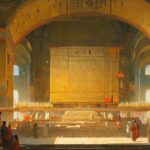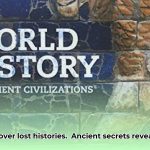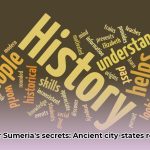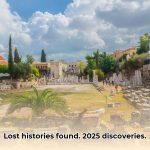Ready to ditch the dusty old history textbook and dive into some seriously cool ancient history civilizations trivia? Forget boring dates and names—we’re uncovering the juicy bits, the mind-blowing facts, and the “wait, really?” moments that make ancient history way more interesting than you ever thought possible. We’ll tackle intriguing trivia questions, but don’t worry, it’s not a test! Each question is a doorway to a fascinating story, packed with details that’ll leave you buzzing. Get ready to become an instant ancient history expert, armed with enough knowledge to impress your friends and family (and maybe even your history teacher!). Let’s explore some awesome secrets from the past! For further reading, check out these great ancient history books.
Ancient History Trivia: Unveiling Secrets of the Past
Ever wonder about the vibrant colors once adorning the Great Sphinx or the mysteries surrounding the lost city of Atlantis? Ancient history is packed with intriguing facts, surprising discoveries, and enduring puzzles. Let’s dive into some captivating trivia that will make you see the past in a whole new light.
-
The Great Sphinx’s Colorful Secret: You probably picture the Great Sphinx of Giza as a sandy-colored monument. But ancient depictions and recent research suggest it was originally painted in vibrant hues of red, yellow, and blue! Imagine that colossal lion, brilliantly colored, standing guard over the Giza plateau. The colors weren’t just for decoration; they likely held deep symbolic meaning in ancient Egyptian religious beliefs and artistic expression, reflecting their rich spiritual world. Scientists are still working to understand precisely what pigments and techniques were used, and ongoing research may offer even more stunning revelations about its original appearance. Did cultural nuances play a key role in these ancient Egyptian art choices? What materials were used to paint the Great Sphinx, and how did they withstand the elements for so long?
-
Atlantis: Myth, Metaphor, or Lost Civilization?: The legendary city of Atlantis, a utopian civilization swallowed by the ocean, continues to fascinate. Some see it as a pure myth, a powerful metaphor for the ephemeral (short-lived) nature of power and civilizations. Others, however, cling to the possibility that it may represent a real, albeit lost, society. While no definitive archaeological evidence confirms its existence, the story inspires ongoing discussions about the potential of advanced ancient civilizations and the mysterious disappearances of entire cultures. The mystery persists, fueling exploration and prompting us to wonder what other submerged secrets the ocean might hold. Could advanced technology explain the Atlantis legend? Which philosophers made Atlantis a central part of their philosophical discourse, and what were their main arguments?
-
Roman Engineering Marvels: Plumbing the Depths of Ancient Innovation: The Romans weren’t just great warriors and conquerors; they were also brilliant engineers. Their sophisticated sanitation systems, including aqueducts (artificial channels for conveying water), sewers, and public baths, were incredibly advanced for their time. Picture this: a vast network of pipes efficiently carrying fresh water across remarkable distances, supplying not only homes but also impressive public facilities. This advanced infrastructure was crucial to supporting large populations and keeping people healthy, representing a significant advancement in public health that was unparalleled for centuries. How has Roman infrastructure influenced modern engineering? What materials did the Romans use to build their aqueducts, and how did they prevent water from leaking?
-
Decoding Hieroglyphs: Unlocking the Secrets of Ancient Egypt: Ever wonder how we understand ancient Egyptian texts? The Rosetta Stone, a stone inscribed with the same text in three different scripts (Greek, Demotic, and hieroglyphs), played a crucial role. By comparing the known Greek text with the unknown hieroglyphs, scholars painstakingly deciphered this ancient language. This seemingly small stone unlocked a treasure trove of information about Egyptian culture, religion, history, and daily life. It’s a remarkable example of how a single artifact can transform our understanding of a whole civilization. What secrets remain hidden within undeciphered ancient texts? Beyond the Rosetta Stone, what other discoveries have aided in the translation of hieroglyphs?
-
Babylonian Mathematics: A Foundation for Modern Calculations: The Babylonians, a civilization that thrived in Mesopotamia, made astounding contributions to mathematics. They developed advanced systems for calculating areas and volumes, working with complex equations centuries before similar advancements in other parts of the world. Their unique base-60 number system, incredibly sophisticated for its time, is still reflected in our modern measurement of time (60 seconds in a minute, 60 minutes in an hour). This demonstrates the enduring influence of Babylonian mathematical innovations on our world today. Have Babylonian innovations been pivotal in technological development, and how? How did the Babylonians use their mathematical knowledge in practical applications, such as construction and astronomy?
-
Mayan Calendars: Tracking Time with Astronomical Precision: The Mayan civilization possessed an incredibly deep understanding of astronomy. Their calendar systems, famously precise, tracked both the solar year and the cycles of Venus with remarkable accuracy. This wasn’t just a matter of keeping track of time; it reflects their advanced observation skills and profound knowledge of celestial mechanics (study of the motions of celestial objects). The complexity of their calendars showcases their intellectual sophistication and highlights the accuracy of their astronomical observations. Did ancient Mayan calendars provide insights into world events based on celestial alignment? In what ways did the Mayan calendar influence their religious beliefs and agricultural practices?
-
The Terracotta Army: Guardians for Eternity: The Terracotta Army, unearthed near the tomb of Qin Shi Huang, the first emperor of a unified China, stands as one of the most impressive archaeological discoveries ever made. Thousands of life-sized terracotta soldiers, horses, and chariots were created to accompany the emperor into the afterlife. The sheer scale of the project, the intricate detailing of each figure, and the immense skill involved underscore the power of the emperor and the artistry of ancient Chinese craftspeople. What inspired the construction of the Terracotta Army? How were the terracotta warriors created, and what materials were used in their construction?
-
The Ancient Olympic Games: More Than Just Athletic Competition: The ancient Olympic Games held far greater significance than just athletic competitions. They were a major religious and cultural festival, honoring Zeus, the king of the gods, and uniting people from across the Greek world. The games served as a powerful symbol of peace, unity, and cultural exchange, creating a unique sense of community and shared identity across different city-states. Their legacy continues to resonate today. In what ways did the Olympics serve as a political tool in Ancient Greece? What events were included in the ancient Olympic Games, and how did they differ from the modern Olympics?
-
Cleopatra: Last Pharaoh of Egypt’s Ptolemaic Kingdom: Some believe that Cleopatra, the last active ruler of the Ptolemaic Kingdom of Egypt, was a cunning and powerful leader, while others view her more critically. Regardless of these perspectives, her iconic story illustrates the fascinating mix of Greek and Egyptian culture during this period and the final chapter of a powerful dynasty. Her life and reign remain a subject of much debate and continuing historical study. What can we learn from historical perspectives on Cleopatra? How did Cleopatra use her political skills to maintain power and influence in a male-dominated world?
-
Ancient Greek Innovations: The Ancient Greeks weren’t just philosophers and artists; they were also innovators in various fields. They made significant contributions to mathematics, science, theatre, architecture (consider the Parthenon!), and more. The impact of their ingenuity continues to shape our world, a testament to their lasting contributions. What technological innovations from Ancient Greece still influence modern society? Who were some of the most influential scientists and inventors in ancient Greece, and what were their key discoveries?
This is just a glimpse into the fascinating world of ancient history. Each discovery reveals more about the ingenuity, artistry, and complexities of past civilizations. So, the next time you see a historical monument or hear about an ancient civilization, remember the incredible stories and secrets they hold. Keep exploring – there’s always more to uncover!
How did environmental factors influence the rise and fall of ancient civilizations?
Key Takeaways:
- Access to reliable water sources was crucial for the development of early agricultural societies. Lack of water, conversely, often led to conflict and societal decline.
- Climate change, including prolonged droughts and devastating floods, played a significant role in the collapse of numerous civilizations.
-
Unsustainable practices like deforestation and intensive agriculture depleted resources and damaged the environment, contributing to societal instability.
-
Trivia Question: Did the fertile crescent’s abundance always guarantee prosperity?
-
Answer: No.
-
Explanation: The Fertile Crescent, birthplace of agriculture, experienced periods of both incredible flourishing and devastating collapse. While its initial richness supported the rise of Mesopotamia, unsustainable farming techniques, like over-irrigation, led to soil salinization (salt accumulation in the soil). This, coupled with periodic droughts, significantly impacted crop yields and ultimately contributed to the decline of several powerful empires. It’s a stark reminder that even bountiful environments aren’t immune to mismanagement. Think of it like this: a fertile field eventually becomes barren without proper care. How did environmental factors influence the rise and fall of ancient civilizations? The answer lies partially in their ability to manage the very resources that fueled their growth. What specific crops were cultivated in the Fertile Crescent, and how did they contribute to the development of agriculture?
-
-
Trivia Question: How did geography impact the Incan Empire’s success and eventual downfall?
-
Answer: The Andes Mountains provided both advantages and disadvantages.
-
Explanation: The Inca’s impressive agricultural terraces showcased their ingenuity in adapting to the challenging Andean terrain. However, their reliance on a complex system of high-altitude agriculture, vulnerable to climate shifts, proved to be a weakness. El Niño events, characterized by unpredictable climate variations, caused devastating floods and droughts that impacted food production. These environmental shocks exacerbated existing vulnerabilities, accelerating the Empire’s decline. How did environmental factors influence the rise and fall of ancient civilizations? In the Inca’s case, a geographically-challenged empire ultimately succumbed to nature’s unpredictability. What were the primary crops grown on the Incan agricultural terraces, and how did they adapt to the high-altitude environment?
-
-
Trivia Question: Was the Roman Empire immune to the impacts of environmental change?
-
Answer: Absolutely not.
-
Explanation: The Roman Empire, known for its impressive infrastructure and military might, wasn’t impervious to the effects of environmental factors. Deforestation for timber and construction led to soil erosion and flooding. Climate shifts, including colder periods, caused crop failures and food shortages. These environmental stresses, coupled with political and economic instability, weakened the empire and contributed to its eventual collapse. How did environmental factors influence the rise and fall of ancient civilizations? They often acted as catalysts, exacerbating existing societal problems and hastening decline. The Roman Empire serves as a potent case study of this. Was the construction of aqueducts more harmful than helpful for the environment, regarding the Roman Empire? What specific policies did the Roman Empire implement to manage its natural resources, and how effective were they?
-
-
Trivia Question: Did the Maya civilization fall solely due to warfare?
-
Answer: No, several factors contributed.
-
Explanation: While warfare and internal conflict certainly played a significant role in the Classic Maya collapse, prolonged droughts were a critical factor. Declining rainfall severely impacted agricultural productivity, leading to food shortages, social unrest, and ultimately, the abandonment of major cities. It’s a complex story, not a simple narrative of conquest. How did environmental factors influence the rise and fall of ancient civilizations? In the Maya’s case, it was intertwined with internal conflict, but drought acted as the final blow. In what ways could Mayan society have adapted to the prolonged drought that contributed to its downfall? What evidence suggests that the Maya civilization experienced prolonged periods of drought, and how did this impact their society?
-
-
Trivia Question: What environmental challenges did the Easter Islanders face leading to their civilization’s decline?
-
Answer: Deforestation and resource depletion.
-
Explanation: The inhabitants of Easter Island (Rapa Nui) dramatically altered their environment through deforestation, leading to soil erosion, loss of biodiversity, and reduced agricultural productivity. The loss of trees impacted their ability to build canoes for fishing and transport, exacerbating resource scarcity. This classic example highlights the dangers of overexploitation and resource mismanagement. How did environmental factors influence the rise and fall of ancient civilizations? Easter Island’s story serves as a cautionary tale about the consequences of ignoring environmental limits. Was deforestation an avoidable mistake for the Easter Islanders? What is the “collapse” theory associated with Easter Island, and what are some alternative explanations for their societal changes?
-
Ancient Egypt’s Essential Contributions: A Deep Dive into Societal Structures
Key Takeaways:
- Ancient Egypt’s social structure, a rigid hierarchy topped by the Pharaoh, ensured stability for centuries.
- The concept of ma’at (harmony and balance) permeated all aspects of Egyptian life, influencing social order and individual responsibilities.
- While largely static, subtle social mobility existed; the exact degree remains a topic of ongoing debate.
The Pharaoh: Divine Ruler and Supreme Authority
Did you know the Pharaoh wasn’t just a king? He was considered a divine intermediary between the gods and the people. This belief formed the bedrock of Ancient Egypt’s Essential Contributions: A Deep Dive into Societal Structures. His authority was absolute, extending to every facet of life—from matters of state to religious ceremonies. This divine right to rule was crucial in maintaining social order. Did the perceived divinity of the Pharaoh ever lead to social uprisings or resistance? What were some of the key responsibilities and duties of the Pharaoh in ancient Egyptian society?
The Priest Class: Guardians of Ma’at and the Afterlife
Next in line were the priests. Their power stemmed from their control over religious beliefs and practices. They oversaw temples, interpreted divine will, and played a significant role in the economy. Powerful indeed, their influence extended beyond the spiritual realm. Their role in maintaining ma’at, the cosmic order, was paramount. Think of them as the moral compass of the society. How was membership in the ancient Egyptian priestly class determined or maintained? What specific rituals and ceremonies did the priests perform, and how did they reinforce their authority?
Scribes: Keepers of Knowledge and Power
Then, we have the scribes, the intellectual elite of ancient Egypt. Their literacy made them indispensable across society, working in government, temples, and even private households. They recorded transactions, maintained official records, and preserved vital knowledge. Their ability to read and write gave them significant power and influence. Without them, the intricate social structure would have crumbled. Did scribes have opportunities for social mobility within ancient Egyptian society? What types of texts and documents did scribes create, and how did they contribute to the administration of ancient Egypt?
Soldiers and Officials: Maintaining Order and Enforcing Laws
Both soldiers and government officials held significant power, maintaining order and enforcing the law. The army protected Egypt’s borders and internal security, while officials managed the bureaucracy and ensured the smooth functioning of the government. They were the pillars of the system, ensuring its stability and strength. What were the daily lives of soldiers like and how did it differentiate from government officials in Ancient Egypt? How was the ancient Egyptian army organized, and what weapons and tactics did they use in warfare?
Craftsmen and Farmers: The Backbone of the Economy
Who were the backbone of the ancient Egyptian economy? The craftsmen and farmers, of course! From skilled artisans creating intricate jewelry and furniture to farmers working tirelessly in the fertile Nile Valley, these groups provided the material wealth that sustained the entire civilization. They were the true engine of Egyptian prosperity. Their labor was essential, ensuring the survival of the entire system. How specialized were the craft professions in ancient Egypt? What tools and techniques did ancient Egyptian farmers use to cultivate the land and ensure a successful harvest?
Slaves: The Unseen Workers
What about slaves? Their status and treatment remain a topic of debate among historians. While commonly portrayed as the main force behind monumental construction, recent research suggests this might be an oversimplification. Further research into this area is crucial for a more nuanced understanding of this aspect of Ancient Egyptian society. Their lives were undoubtedly difficult, shrouded in mystery. Did slaves have any legal rights or protections in ancient Egypt? What evidence exists regarding the treatment and living conditions of slaves in ancient Egypt?
The Deir el-Medina Strike: A Crack in the System
The Deir el-Medina workers’ strike in the late New Kingdom provides a fascinating glimpse into the undercurrents of discontent. This event, where workers protested against delayed payment and unfair treatment, demonstrates that even a seemingly unbreakable social structure can experience cracks. It was a significant event, highlighting the simmering tensions within Egyptian society. How did the Deir el-Medina strike impact the social and political landscape of ancient Egypt at the time? What can the Deir el-Medina strike tell us about the social and economic challenges faced by ordinary workers in ancient Egypt?
Deciphering Ancient Hieroglyphs: A Step-by-Step Guide to Understanding Egyptian Scripts
Key Takeaways:
- Ancient Egyptian writing evolved over time, from hieroglyphs to hieratic and demotic scripts.
- Understanding hieroglyphs requires knowledge of their various forms (ideograms, phonograms, determinatives).
- The Rosetta Stone was crucial in deciphering hieroglyphs, providing a key to understanding their phonetic values.
Cracking the Code: A Look at Hieroglyphs
Ever wondered how we understand ancient Egyptian texts? It all starts with deciphering ancient hieroglyphs. These aren’t just pretty pictures; they’re a complex writing system that took centuries to unlock. Think of it like a puzzle with thousands of pieces – each symbol representing a sound, an idea, or both! How did the invention of papyrus influence the development of hieroglyphic writing? What were the different types of writing surfaces used in ancient Egypt, and how did they impact the development of writing?
The Rosetta Stone: A Linguistic Breakthrough
The Rosetta Stone, discovered in 1799, is arguably the most important artifact in the history of Egyptology. Why? Because it contains the same text in three scripts: hieroglyphs, demotic (a cursive script used in everyday life), and Ancient Greek. Knowing Ancient Greek, scholars could use the Greek text as a key to decipher the others. This was a monumental turning point – similar to finding the instruction manual for a centuries-old machine! What role did the discovery of the rosetta stone play in modern understanding of ancient languages? Who were the key scholars involved in deciphering the Rosetta Stone, and what were their main contributions?
Types of Hieroglyphs: More Than Meets the Eye
Hieroglyphs weren’t all uniform; they used various symbol types:
- Ideograms: Pictures representing objects or concepts directly (e.g., a sun for the sun god Ra).
- Phonograms: Symbols representing sounds or syllables (e.g., a picture of a mouth could represent the sound “r”).
- Determinatives: Symbols that didn’t represent sounds but clarified the meaning of the word (e.g., a symbol of a person after a word indicating it’s a person’s name).
Think of them as building blocks of language. Combining different combinations of these types created words and sentences. How did these variations in ancient languages complicate deciphering ancient hieroglyphs? How did the Egyptians use determinatives to clarify the meaning of words and avoid ambiguity?
A Step-by-Step Approach to Deciphering
While fully mastering hieroglyphs takes dedication, here’s a simplified approach:
- Identify the Script: Determine whether you’re looking at hieroglyphs, hieratic, or demotic script.
- Analyze Symbol Types: Categorize individual symbols into ideograms, phonograms, or determinatives.
- Understand Context: Consider the surrounding symbols and overall text to understand the word’s meaning in context.
Beyond the Rosetta Stone: Modern Methods
While the Rosetta Stone was crucial, modern deciphering ancient hieroglyphs goes beyond that initial breakthrough. Researchers now employ advanced technology, including digital tools and sophisticated linguistic analysis, to further refine our understanding of this ancient writing system. This allows us to explore a wealth of previously inaccessible information. And how has technology helped make the process of deciphering ancient hieroglyphs more accessible and effective? What are some of the digital tools and resources that are used by modern Egyptologists to study hieroglyphs?
Revealing Ancient Secrets
Through the painstaking work of scholars, we’ve rediscovered a vast collection of ancient Egyptian texts, narratives, and rituals. These previously hidden stories illuminate different facets of their world. Imagine unveiling the secrets held within tombs, temples, and papyri––that’s the power of understanding hieroglyphs! They are not merely symbols, but windows into the past. What major historical events or cultural practices have been revealed through the decipherment of ancient hieroglyphs? What are some of the ethical considerations involved in studying and interpreting ancient Egyptian hieroglyphs?
- Discover the Best Ancient History Books: A Guide to Inclusive Narratives - August 6, 2025
- Unlock Ancient World History Textbook:A Deeper Understanding - August 6, 2025
- Discover History Alive Ancient World: Sumerian Rise to City-States - August 6, 2025















